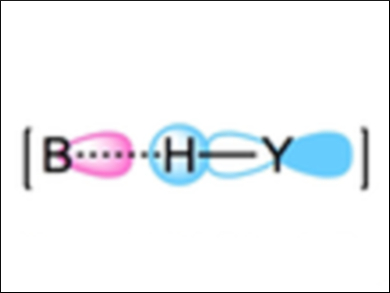Hydrogen bonds are important in many fields of the chemical and biological sciences. An improved understanding of these interactions and their dynamic behavior is, thus, useful.
Taro Nishide, Satoko Hayashi, and Waro Nakanishi, Wakayama University, Japan, have studied the intrinsic dynamic and static nature of neutral hydrogen bonds. The team used a computational method called quantum theory of atoms-in-molecules dual functional analysis (QTAIM-DFA). QTAIM allows researchers to analyze the nature of chemical bonds and interactions. QTAIM-DFA is an extension of the method that can provide a better understanding of weak to strong interactions and their dynamic nature. The analyzed systems were of the type B···H–Y (pictured), with B = H2Se, H2S, H2O, H2CO, H3N, HI, HBr, HCl, HF and Y = SeH, SH, OH, NH2, I, Br, Cl, I.
To study the dynamic nature of the hydrogen bonds, the team used perturbed structures around the fully optimized, static structures. The perturbed structures were generated with a technique named CIV, which uses coordinates based on so-called compliance force constants for the system’s internal vibrations. The static nature corresponds to the data of the fully optimized structures, whereas the intrinsic dynamic nature originates from the data of the perturbed structures generated with CIV.
Based on the results of the QTAIM-DFA calculations, the team could classify the hydrogen bonds by their nature, on a spectrum between purely van der Waals-type interactions of closed-shell components and more covalent, shared-shell interactions. The hydrogen bonds in, e.g., H2Se···HSeH and H3N···HNH2, were characterized as purely closed-shell van der Waals interactions, while HF···HF, for example, has some covalent character.
- Intrinsic Dynamic Nature of Neutral Hydrogen Bonds Elucidated with QTAIM Dual Functional Analysis: Role of the Compliance Force Constants and QTAIM-DFA Parameters in Stability,
Taro Nishide, Satoko Hayashi, Waro Nakanishi,
ChemistryOpen 2018.
https://doi.org/10.1002/open.201800051




